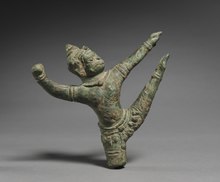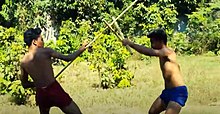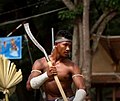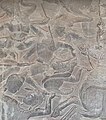This is an old revision of this page, as edited by Pierrevang3 (talk | contribs) at 23:28, 18 March 2024 (redundant). The present address (URL) is a permanent link to this revision, which may differ significantly from the current revision.
Revision as of 23:28, 18 March 2024 by Pierrevang3 (talk | contribs) (redundant)(diff) ← Previous revision | Latest revision (diff) | Newer revision → (diff) Cambodian martial art Bokator demonstration Bokator demonstration | |
| Also known as | Kun L'Bokator |
|---|---|
| Focus | Striking, ground fighting, stick fighting, sword fighting, battlefield, |
| Hardness | Full-contact |
| Country of origin | |
| Famous practitioners | San Kim Sean (Grandmaster), Tharoth Sam, Nang Sovan, Chan Rothana |
| Descendant arts | Kun Khmer, Muay Boran, Muay Thai, Muay Lao |
| Kun L'Bokator, traditional martial arts in Cambodia | |
|---|---|
| UNESCO Intangible Cultural Heritage | |
| Country | Cambodia |
| Domains | Martial arts |
| Reference | |
| Region | Asia and the Pacific |
| Inscription history | |
| Inscription | 29 November 2022 (17th session) |
| List | Inscribed in 2022 (17.COM) on the Representative List of Intangible Cultural Heritage of Humanity |
 | |
Bokator (Template:Lang-km, lbŏkkâtaô [lɓokkatao]) or Kun L'Bokator (គុនល្បុក្កតោ, kun lbŏkkâtaô [kun lɓokkatao], lit. 'the art of pounding the lion') is an ancient Cambodian battlefield martial art. It is one of the oldest fighting systems existing in the world and is recognised as intangible cultural heritage by the UNESCO.
Oral tradition indicates that Bokator (or an early form thereof) was the close-quarter combat system used by the ancient Cambodian armies before the founding of Angkor. A common misconception is that Bokator refers to all Khmer martial arts, while in reality it only represents one particular style. The martial art is believed to be the precursor of all forms of boxing present in the former provinces of the Khmer empire, namely Kun Khmer in Cambodia, Muay Lao in Laos and Muay Thai in Thailand.
History


Bokator is considered to be the oldest martial art currently being practiced in the Kingdom of Cambodia. Its origin can be traced back to the 1st century AD. The word "Bokator" is mentioned in the first Khmer dictionary developed in 1938 by the Buddhist scholar Chuon Nath. The term is believed to derive from the phrase bok tao meaning "to pound a lion". According to the origin myth, a lion was attacking a village when a warrior, armed with only a knife, defeated the animal bare-handed, killing it with a single knee strike.
Bokator as practised today represents a modern form, among other Khmer fighting systems, of the martial art used by Khmer soldiers during the Angkor period and depicted on the various carvings and bas-reliefs of the Angkor temples.
 Stone carving of the rising knee fighting stance. Located at the Bayon temple (late 12th or early 13th century).
Stone carving of the rising knee fighting stance. Located at the Bayon temple (late 12th or early 13th century). Bokator martial artist demonstrates the rising knee fighting stance.
Bokator martial artist demonstrates the rising knee fighting stance.
The former capital, Longvek, use to serve as center of the country's military. It was a gathering point for people of knowledge including scholars and martial artists. According to bokator master Om Yom, areas such as Svay Chrum District, Kraing Leav and Pungro in Rolea B'ier District of Kampong Chhnang Province used to be areas known for training in martial arts. The Royal Cambodian Armed Forces continues to train in that area today.
20th century

Bokator was practiced by members of the anti-colonial Khmer Issarak movement founded in 1945. During the troubled Khmer Republic era from 1970 to 1975, the practice of Bokator led to suspicions of mutiny in both Khmer Rouge-controlled and government-regulated areas. As a result, Bokator fighters did not publicly train but had to resort instead to secret trainings. At the time of the Pol Pot regime (1975–1979) those who practiced traditional arts were either systematically exterminated by the Khmer Rouge, fled as refugees or stopped teaching and hid. After the Khmer Rouge regime, the Vietnamese occupation of Cambodia began and native martial arts were completely outlawed. San Kim Sean is often referred to as the father of modern bokator and is largely credited with reviving the art. During the Pol Pot era, San Kim Sean had to flee Cambodia under accusations by the Vietnamese of teaching hapkido and Bokator (which he was) and starting to form an army, an accusation of which he was innocent. Once in America he started teaching hapkido at a local YMCA in Houston, Texas and later moved to Long Beach, California. After living in the United States and teaching and promoting hapkido for a while, he found that no one had ever heard of bokator. He left the United States in 1992 and returned home to Cambodia to give bokator back to his people and to do his best to make it known to the world.
21st century
In 2001, San Kim Sean moved back to Phnom Penh and after getting permission from the new king began teaching bokator to local youth. That same year in the hopes of bringing all of the remaining living masters together he began traveling the country seeking out bokator lok kru, or instructors, who had survived the regime. The few men he found were old, ranging from sixty to ninety years of age and weary of 30 years of oppression; many were afraid to teach the art openly. After much persuasion and with government approval, the former masters relented and Sean effectively reintroduced bokator to the Cambodian people. The first ever national Bokator competition was held in Phnom Penh at the Olympic Stadium in 2006. The competition involved 300 participants.
Bokator has been inscribed in 2022 (17.COM) on the Representative List of the Intangible Cultural Heritage of Humanity.
Bokator boasts around 7,000 practitioners both in Cambodia and abroad. Dedicated grandmasters, including Ith Pen, Sen Sam Ath, San Kim Sean, Ros Serei, Am Yom, Suong Neng, Ponh Keun, Voeng Sophal, Ke Sam On, Kim Chiev, Chet Ay, and Kao Kob, work tirelessly to preserve and pass on this tradition. Across thirteen Cambodian provinces, Bokator community schools exist, where these grand masters teach and receive support from the local communities.
To further promote and safeguard Bokator, the Cambodia Kun Bokator Federation was established under the National Olympic Committee of Cambodia, with backing from the Ministry of Education, Youth, and Sports. This effort allows masters and apprentices from across the country to continue their practice. The art is also practiced outside Cambodia, notably in the United States, Europe, and Australia, with support from Cambodian diaspora communities. In 2020, masters from various Cambodian provinces formed an interprovincial network to share experiences, training techniques, and document their knowledge. Notably, Bokator was added as a new discipline for the Southeast Asian Games in 2023. In India, the first National Kun Bokator Championship was held in Srinagar in 2023, organized by the Kun Bokator Federation of India. Representatives from 12 states participated in this event, alongside two coaches from Cambodia who shared their expertise. A National Level Kun Bokator Seminar was conducted for coaches and referees to ensure smooth proceedings. The championship has sparked increased interest in the sport among Kashmiri players.
The Cambodia Kun Bokator Federation (CKBF), established in 2004, plays a pivotal role in facilitating national-level training, workshops, seminars, and documenting Bokator techniques and skills. It provides a platform for masters to exchange information and knowledge. Since 2020, the Ministry of Education, Youth, and Sports (MoEYS) has been working to integrate Bokator into formal and non-formal education curricula, while it is already part of the training program for the police department and military forces. Masters, with at least five years of experience in Bokator, pass on their knowledge and skills to new generations, often in their homes, offering flexible training schedules to accommodate student apprentices, who are typically local public school students. Male and female practitioners train together multiple times a week.
Tournaments occur at regional and national levels, sometimes with coordination by the Cambodia Kunbokator Federation (CKBF) and active participation from the masters. CKBF also supports the organization of performances, training sessions, and documentation initiatives to ensure the art's continuity.
Style overview

Bokator is characterized by hand-to-hand combat along with heavy use of weapons. Bokator uses a diverse array of elbow and knee strikes, shin kicks, submissions and ground fighting. Some of the weapons used in bokator include the bamboo staff, short sticks, sword and lotus stick (20 cm long wooden weapon).
When fighting, bokator exponents still wear the uniforms of ancient Khmer armies. A krama (scarf) is folded around their waist and blue and red silk cords called, sangvar day are tied around the combatants head and biceps. In the past the cords were believed to be enchanted to increase strength, although now they are just ceremonial. Advanced Bokator practitioners learn to use the krama as a weapon. It serves various purposes including pulling, tying, wrestling, choking, and joint locking. Additionally, they can employ the scarf as a whip to target an opponent's eyes, impairing their vision. Stones can also be concealed within the scarf and launched akin to ancient sling projectiles.
The art contains 341 sets which, like many other Asian martial arts, are based on the study of life in nature. For example, there are styles of elephant, duck, crab, horse, bird and crocodile with each containing several techniques. Unlike its neighbors, Cambodia has a history of being a Hindu nation. In addition to animal styles, bokator has techniques based on Hindu deities such as hanuman and apsara.
For his school of bokator, San Kim Sean developed a krama based system similar to a belt system to organize and represent the training levels. Bokator encompasses over 10,000 techniques, and as students progressively master them, they receive different-colored krama to denote their advancement. Starting with a white krama, beginners advance through green, blue, red, brown, and then ten degrees of black. A gold krama is reserved for grandmasters who have devoted their lives to Bokator.
Some Bokator students dedicate their lives to mastering the martial art. Many of them reside within the martial arts school. They obediently follow their master's lead, who assumes dual roles as an instructor and a guardian, providing sustenance and attending to their well-being. These students endure rigorous training sessions, often lasting up to eight hours per day. Classes usually end with meditation and breathing exercises meant to help blood flow, blending spiritual and physical aspects.
Bokator exhibits slight regional variations, encompassing differences in physical techniques, tools, terminology, and favored skills. Beyond martial arts, it finds artistic applications in Chhay Yam musical dance and Khmer-style theatrical performances such as Lakhon Bassac. Its rich symbolism and meanings make it suitable for creative interpretations in theater, literature, poetry, story-telling, and visual arts like painting and photography.
In popular culture
In 2017, Bokator was highlighted in the successful Cambodian martial arts film Jailbreak. Bokator is the primary martial art used in the popular dystopian trilogy Arc of Scythe written by Neal Shusterman; the novels additionally use a fictional form of Bokator called "Black Widow Bokator" which is shown and described more offensive and violent form of this martial art. In 2022, Stephen Schwartz, the producer behind the film Power Rangers: Origins, noticed Bokator practitioner Kim Sambo for his martial arts skills. As a result, Sambo contributed to filmmaking by serving as a set organiser for battle scenes and incorporating Bokator into them.
Image gallery
-
 A bokator martial artist carrying a phkak, a traditional Khmer axe.
A bokator martial artist carrying a phkak, a traditional Khmer axe.
-
 Bas-relief of the King carrying a phkak, a traditional Khmer axe. Located at Angkor Wat (1100s)
Bas-relief of the King carrying a phkak, a traditional Khmer axe. Located at Angkor Wat (1100s)
-
 A Bokator practitioner demonstrates a thrust kick (tekt) on his training partner.
A Bokator practitioner demonstrates a thrust kick (tekt) on his training partner.
-
 Wooden arm shields known as staupe or Cambodian "tonfa"
Wooden arm shields known as staupe or Cambodian "tonfa"
-
 Bas-relief of arm shield. Located at Angkor Wat (1100s)
Bas-relief of arm shield. Located at Angkor Wat (1100s)
-
 Elbow to the jaw pass the arm shield. Bas-relief located at Angkor Wat (1100s)
Elbow to the jaw pass the arm shield. Bas-relief located at Angkor Wat (1100s)
-
 Bokator spear and long staff
Bokator spear and long staff
-
 Ground technique: leg grab and spear attack from the ground. Bas-relief at Bayon temple (12th/13th century)
Ground technique: leg grab and spear attack from the ground. Bas-relief at Bayon temple (12th/13th century)
-
 Bas relief of rear naked choke
Bas relief of rear naked choke
-
 Angkor statue of grappling by the Khmer Empire
Angkor statue of grappling by the Khmer Empire
-
 Battlefield scene at Angkor Wat. Techniques of submission holds in the upper left and lower left with thrust kick in the middle and elbow strike in the center.
Battlefield scene at Angkor Wat. Techniques of submission holds in the upper left and lower left with thrust kick in the middle and elbow strike in the center.
-
 Behind the back submission hold on the left. Ground fighting in the middle. Bas relief at Angkor Wat (1100s)
Behind the back submission hold on the left. Ground fighting in the middle. Bas relief at Angkor Wat (1100s)
-
 Bokator knife (Kambet Bantoh)
Bokator knife (Kambet Bantoh)
-
 Bas-relief at Angkor Wat of a Hanuman style single leg headlock
Bas-relief at Angkor Wat of a Hanuman style single leg headlock
-
 Climbing attack: martial artist climbs the quad to attack from above. At Angkor Wat.
Climbing attack: martial artist climbs the quad to attack from above. At Angkor Wat.
-
 Knee attack stone carving at Bayon temple(12th/13th century)
Knee attack stone carving at Bayon temple(12th/13th century)
-
 The "trabiet" is a rice threshing tool used by farmers and a martial arts weapon.
The "trabiet" is a rice threshing tool used by farmers and a martial arts weapon.
-
 Bas-relief of elbow strike. Located at Angkor Wat (12th century)
Bas-relief of elbow strike. Located at Angkor Wat (12th century)
-
 Bas-relief of elbow strike. Located at Angkor Wat (12th century)
Bas-relief of elbow strike. Located at Angkor Wat (12th century)
-
 Knee strike at a distracted opponent. Bas-relief from a mural in Angkor Wat ruins.
Knee strike at a distracted opponent. Bas-relief from a mural in Angkor Wat ruins.
See also
References
- ^ Meixner, Seth (October 14, 2007). "'Bokator' makes sudden comeback in Cambodia". Taipei Times. Retrieved 2019-08-09.
- ^ Graceffo, Antonio. "Cambodian and Chinese Martial Arts Compared (English language paper)". Retrieved 6 March 2024.
- ^ De Cesaris, Marco (8 November 2013). Muay Thai Boran: The Martial Art of Kings. Edizioni Mediterranee. ISBN 8827223541.
- "Muay Korat".
- Teh, Cheryl (2018-06-28). "Faster, Higher, Stronger: Traditional Sports in ASEAN" (PDF). ASEANFocus (3/2018). ISEAS-Yusof Ishak Institute: 26. ISSN 2424-8045. Archived from the original on 10 March 2023. Retrieved 2023-03-10.
Muay Thai may enjoy much greater popularity in modern times but its origins are believed to come from Bokator which even predates the Angkor-era
- Bryan, Andrew (2022-05-31). "The Complicated History of Muay Thai". Black Belt. Retrieved 2024-01-26.
Bokator, for example, is sometimes claimed to be the father of muay Thai
- Carruthers, Marissa (2018-04-17). "Martial art that gave birth to Muay Thai has revival in Cambodia". South China Morning Post. Archived from the original on 10 March 2023. Retrieved 2023-03-10.
He says that while regional sports such as Muay Thai (Thai boxing) are famous throughout the world, their origins come from bokator.
- Wheaton, Tim (12 October 2023). "What is Muay Lao? Laos' Hidden Gem". Muay Thai.
There's evidence to suggest that a style akin to kickboxing was practiced by the Khmers during the Angkor era. Given the dominance of the Angkor kingdom over most parts of this region during that period, it's widely believed that Muay's origins can be traced back to the early Khmer people.
- ^ "Muay Lao: the Kick Boxing Scene in Vientiane, Laos". Dietmar Temps Photography.
Ask a European about Asian kick boxing, he for sure will answer: "yes, Thai boxing!". Ask Thai people about kick boxing, you most likely get the answer: "Of course, it's Muay Thai, we invented it, and we are the best!". But Laos's people will probably explain, that "Muay is a Southeast Asian traditional martial arts with its roots in Cambodia, the Thai people call it Muay Thai, and here in Laos the name is Muay Lao."
- Graceffo, Antonio (7 October 2013). "Muay Lao: The Forgotten Art of Kickboxing". USA Dojo.
Adjarn Ngern, the head coach of the Lao National Muay Lao Team, told me that Muay Lao is a much smaller sport in Lao than is Muay Thai in Thailand. Professional fights are only held in the National Stadium twice per month. There are only a handful of registered professional fighters in the whole country. "How is Muay Lao different than Muay Thai?" I asked. "It's exactly the same." Said the Adjarn. "Cambodians are angry about the name Muay Thai. They feel they invented kickboxing and it should be called by the Cambodian name, Bradal Serey, not Muay Thai. What do you think of that?" Without a second's hesitation he answered, "Muay Thai was invented in Cambodia, but Thailand has the money and got famous."
- ^ Sony, Ouch; Keeton-Olsen, Danielle (12 January 2021). "An Ancient Martial Art, Transformed by Time, War, Seeks Return to Prominence". Voice of America. Retrieved 26 February 2021.
- "Browse the Lists of Intangible Cultural Heritage and the Register of good safeguarding practices".
- Ray, Nick; Daniel Robinson; Greg Bloom (2010). Cambodia. Lonely Planet. p. 99. ISBN 978-1-74179-457-1.
- ^ "Kun L'Bokator, traditional martial arts in Cambodia". unesco.org.
- Curtin, Joseph (4 September 2015). "Back in the ring and fighting to be remembered". The Phnom Penh Post. Retrieved 26 February 2021.
- Wheaton, Tim (23 October 2023). "Bokator – The Ancient Art of Kun Lbokator". muaythai.com. Retrieved 1 March 2024.
- Chhorn, Norn (19 October 2022). "Bokator Federation formed for SEA Games". The Phnom Penh Post. Retrieved 2 March 2024.
Bokator as practised today is a modern version of a martial art that was long used by Khmer soldiers on the ancient battlefields of the Khmer Empire.
- "Kbach Kun Khmer Boran". Ministry of Foreign Affairs and International Cooperation of Cambodia. 30 October 2016. Retrieved 2 March 2024.
Kbach Kun Khmer Boran (Khmer martial arts) date back more than a thousand years, as evidenced by carvings and bas-reliefs in the Angkor temples. The martial arts include Bokator, Pradal Serey, Baok Chambab, Kbach Kun Dambong Vèng, amongst others.
- Lim, Nary (31 January 2023). "Archaeologist shows Cambodian martial art sculptures at Khmer temples". Khmer Times. Retrieved 2 March 2024.
A well-rounded archaeologist of the APSARA National Authority has unveiled Cambodian martial art bas-relief sculptures at temples at Angkor Archaeological Park, Siem Reap province. The archaeologist Phoeung Dara said that some Cambodian martial art bas-relief sculptures are related to Kun Khmer, wrestling and Lbokator.
- Buth, Kimsay (23 June 2016). "RCAF Soldiers to Train in Ancient Martial Art". The Cambodia Daily. Retrieved 26 February 2021.
- ^ Graceffo, A. (n.d.). Bokator Khmer: The Ancient Form of Cambodian Martial Arts. Tales of Asia. Retrieved April 4, 2022
- ^ "Nearly wiped out by genocide, Long Beach resident helps revive Cambodian martial art". Long Beach Press Telegram. 2015-09-17. Retrieved 2024-03-05.
- Kay, Kimsong (2006-09-27). "300 Participate in First Bokator Competition". The Cambodia Daily. Retrieved 2024-03-05.
- "Kun L'Bokator, traditional martial arts in Cambodia". Retrieved 2022-12-19.
- "National Kun Bokator Championship organised for first time in Srinagar". Times of India. 8 June 2023. Retrieved 1 March 2024.
- Rodriguez T. Senase, Jose (5 May 2020). "Online availability of Surviving Bokator extended to May 18". Khmer Times. Retrieved 26 February 2021.
- Taing, Rinith (7 February 2018). "The 26-year-old bringing Cambodian history to life through swords". The Phnom Penh Post. Retrieved 2 February 2021.
- Hine, W. (2008, October 3). Bokator master targets expats with short course. The Phnom Penh Post. Retrieved March 14, 2022
- Chhorn, Tith (22 October 2014). "ល្បុក្កតោ ជាមរតកគុនខ្មែរគ្រប់គ្រងអាស៊ីអាគ្នេយ៍ជាង៦០០ឆ្នាំ". Sabay news (in Khmer). Retrieved 8 March 2024.
- Soklim, K. (2021, March 20). Khmer Bokator: A Martial Art Adopted from Animals and Plants. Cambodianess. Retrieved February 8, 2022
- Bokator on the Big Screen, Khmer Times, 2 June 2016
- Richard Kuipers, BiFan Film Review: 'Jailbreak', Variety, 24 July 2017
- Rinith, Taing (2020, August 4). ‘Raya and the Last Dragon,’ due for release next year, brings pride to Cambodia
- Shusterman, Neal (2016). Scythe. Simon & Shusterman.
- "Cambodian Bokator star teaches ancient Cambodian martial art to Power Rangers for Hollywood movie". Khmer Times. 16 October 2023. Retrieved 1 March 2024.
External links
- Bokator Khmer: The Ancient Form of Cambodian Martial Arts
- From battlefield to sport arena: the rebirth of bokator
- Martial Arts Odyssey: Bokator: The Khmer Martial Art (Parts 1 and 2)
